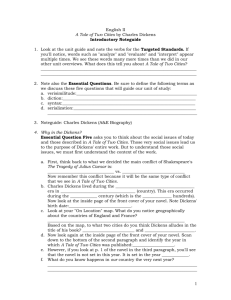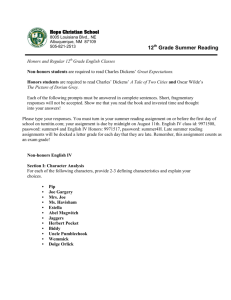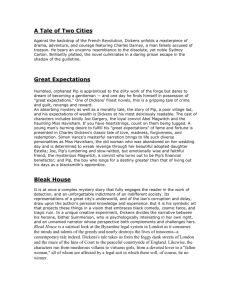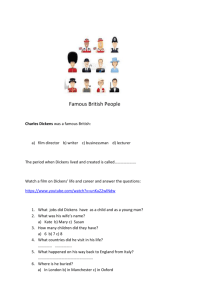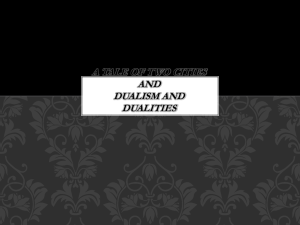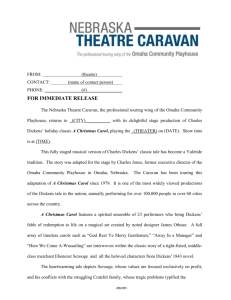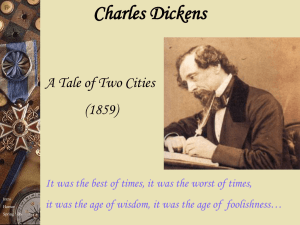31 LETISSIER
advertisement
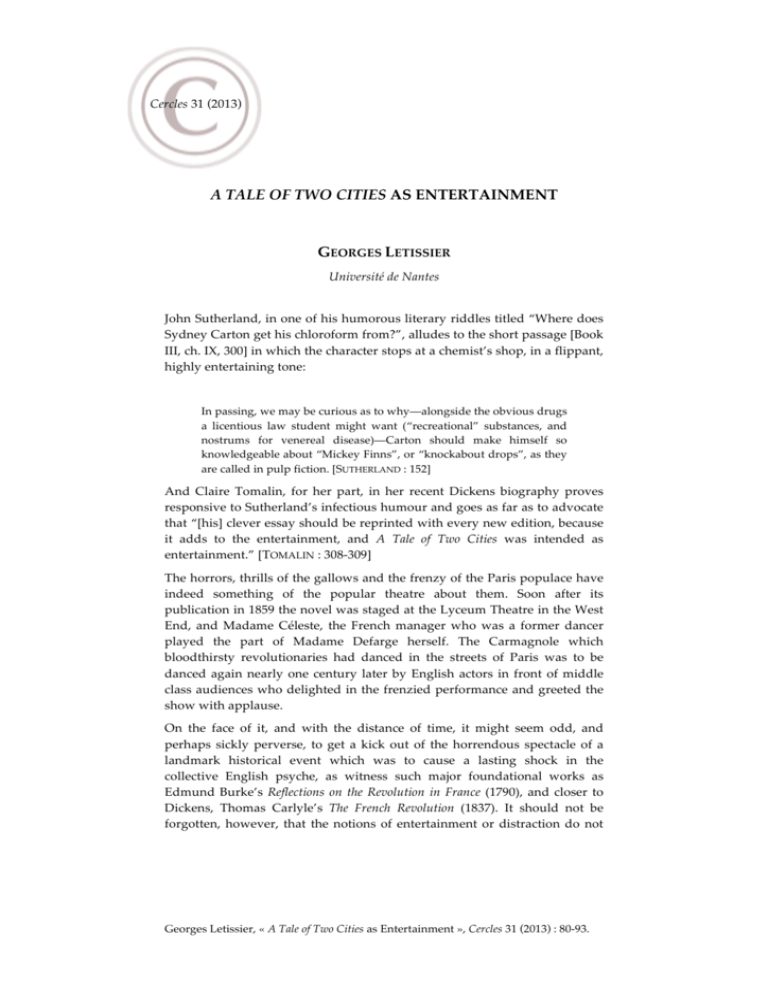
Cercles 31 (2013) A TALE OF TWO CITIES AS ENTERTAINMENT GEORGES LETISSIER Université de Nantes John Sutherland, in one of his humorous literary riddles titled “Where does Sydney Carton get his chloroform from?”, alludes to the short passage [Book III, ch. IX, 300] in which the character stops at a chemist’s shop, in a flippant, highly entertaining tone: In passing, we may be curious as to why―alongside the obvious drugs a licentious law student might want (“recreational” substances, and nostrums for venereal disease)―Carton should make himself so knowledgeable about “Mickey Finns”, or “knockabout drops”, as they are called in pulp fiction. [SUTHERLAND : 152] And Claire Tomalin, for her part, in her recent Dickens biography proves responsive to Sutherland’s infectious humour and goes as far as to advocate that “[his] clever essay should be reprinted with every new edition, because it adds to the entertainment, and A Tale of Two Cities was intended as entertainment.” [TOMALIN : 308-­‐‑309] The horrors, thrills of the gallows and the frenzy of the Paris populace have indeed something of the popular theatre about them. Soon after its publication in 1859 the novel was staged at the Lyceum Theatre in the West End, and Madame Céleste, the French manager who was a former dancer played the part of Madame Defarge herself. The Carmagnole which bloodthirsty revolutionaries had danced in the streets of Paris was to be danced again nearly one century later by English actors in front of middle class audiences who delighted in the frenzied performance and greeted the show with applause. On the face of it, and with the distance of time, it might seem odd, and perhaps sickly perverse, to get a kick out of the horrendous spectacle of a landmark historical event which was to cause a lasting shock in the collective English psyche, as witness such major foundational works as Edmund Burke’s Reflections on the Revolution in France (1790), and closer to Dickens, Thomas Carlyle’s The French Revolution (1837). It should not be forgotten, however, that the notions of entertainment or distraction do not Georges Letissier, « A Tale of Two Cities as Entertainment », Cercles 31 (2013) : 80-93. Georges Letissier / 81 merely entail the light and flimsy but may also be correlated with a profound reflection on the metaphysical implications of the human condition. Blaise Pascal’s “diversion”, which is also translated as distraction or entertainment, comes to mind of course: “As men are not able to fight against death, misery, ignorance, they have taken it into their heads, in order to be happy not to think of them at all” [PASCAL 168 : 49]. Later in his Pensées, he pushes the close link between diversion and death still further, in a way that is most relevant to A Tale, by propounding that “The only thing which consoles us for our miseries is diversion, and yet it is the greatest of our miseries…diversion amuses us, and leads us unconsciously to death” [171 : 49]. The semantic range covered by the notion of entertainment warrants attention in its own right. Indeed, it stems from the Latin intertenere (inter: among and tenere: hold), which implies the idea of holding mutually and by extension keeping up and maintaining, by providing pleasurable interest or occupation, hence the synonymous concept of “diversion” entailing the idea of turning away from one’s usual occupation or keeping one’s mind off some worrying subjects. At a superficial level, Dickens in A Tale appropriates the historical novel popularised by Walter Scott to pass on a message about England in the late 1850s, and more generally, about the condition of England in the wake of the Chartist movement, this diversion, or deviation, is not only temporal but also spatial as the plot shifts from London to Paris, and then shuttles back and forth between Paris and London, before the two urban spaces fuse together as Sara Thornton has shown in a recent article [THORNTON, 2012]. As the novel shows, little Lucie provides the linguistic proof of this cultural and geographical conflation when “she chatter[s] in the tongues of the Two Cities that [are] blended in her life” [Book II, Ch. 21, 203]. So, in a sense, through a deviation, i.e. by straying away from the present, which he nonetheless proved equal to the task of tackling head on shortly after in Our Mutual Friend, Dickens in dealing with the spectacular conflagration of the French Revolution commented on the England he was living in, whilst adumbrating a reflection on the human condition which possibly took on a universal dimension. As usual with Dickens, the question is how to reconcile self-­‐‑contradictory impulses? In the present case, is the serious historical content trivialised by the overly spectacular stance, flaunting gory, blood-­‐‑curdling scenes which are prone to pander to voyeuristic instincts? This, ultimately, raises the issue of A Tale’s posterity, that of an untypical Dickensian novel which nevertheless met with unprecedented editorial success and has been repeatedly adapted for the screen since its publication. Said differently, is Georges Letissier / 82 entertainment antithetical to a more serious analysis of the fiction’s historiographical import or does it make for a reflection on the idiosyncratic, and hybridised way in which Dickens used the format of the historical novel? In the revival of historical novels omnipresent in contemporary British fiction writing, Dickens is invariably acknowledged as a major influence, is this because this blending of high-­‐‑ and low-­‐‑brow cultures, so perceptible in A Tale, anticipate on the category of historiographic metafictions defined much later by Linda Hutcheon? This study will be threefold, proceeding from a cursory analysis of the Tale as literary artifact and fiction pertaining to popular culture to an investigation of entertainment(s) within the space of the novel itself: through both the diegesis and the novel’s economy. In a final part, through the type of “inversion of all experience” [Book III, Ch. 1, 246] which is paradigmatic in the whole novel, it will be argued that entertainments may be construed as the other side, or seamy side of History. “[I]llustrations of old pages in the history of France” [Book II, Ch. 9, 113] : The recreational function of A Tale of Two Cities The obvious way to start from is to point to the novel’s genesis. It originates in the Thespian. Many studies have been dedicated to the bond between A Tale and Wilkie Collins’s The Frozen Deep, with Dickens in the part of Richard Wardour, the lovelorn, self-­‐‑sacrificing lover already gathering many of the attributes of Sydney Carton, whilst Lucy Manette has been shown to resemble closely Ellen Lawless Ternan, who was acting as Lucy Crawford, a less prominent role than that of Clara, Lucy’s Crawford’s sister, played by Maria Ternan. Dickens’s emotional involvement with Ellen is well-­‐‑known and probably accounts, at least partly, for the Inimitable having been “possessed” by the novel’s execution and for his “hav[ing] certainly suffered it all myself”, as he puts it in the preface, referring to a fiction whose events he had of course not witnessed personally. Andrew Sanders and Peter Ackroyd both quote The Dead Heart, a play by the Irish playwright Watts Philipps, as another source [SANDERS : 1; ACKROYD : 820] . It recounts “a tale of self-­‐‑sacrifice at the time of the French Revolution which leads to a substitution at the foot of the guillotine” [ACKROYD : 820]. If anything, it shows that A Tale also falls under the melodrama rubric which, as Peter Brooks has argued in a seminal study, relies upon plotting through the continuous, postponement of the climax that must inevitably bring things to an end, whilst sticking to a fairly straightforward epistemological and moralistic agenda, striving “to find, to articulate, to demonstrate, to ‘prove’ Georges Letissier / 83 the existence of a moral universe, which, though put into question […] does exist and can be made to assert its presence and its categorical force among men.” [BROOKS : 239] By underscoring excesses of emotion and sudden unexpected reversals, whilst keeping up unrelenting suspense before providing a reassuring outcome trimming away all ethical complexities, melodrama would appear to serve an entertaining, recreational function. A Tale might not quite fill the bill though, since, as John Glavin in his groundbreaking study has suggested by borrowing Derrida’s category of the “frivolous”, Sydney Carton, the “failed, marginated figure”[GLAVIN : 140], “sensible of the blight upon him” [Book II, Ch. V, 87] precludes any simplistic, rule-­‐‑of-­‐‑thumb approach to melodrama on the part of Dickens. Interestingly, Holly Furneaux in Queer Dickens comes to a similar observation, albeit from another track, by implying that Carton’s self-­‐‑ effacement does not restore the conventional closure that may be expected from Victorian melodrama. Instead of sealing the triumph of marriage after much emotional turmoil and peaks of passion, Furneaux explains that the “wonderful last speech”, i.e. the final prosopopeia is: a deeply queer statement of Dickens’s total revision of the types of bonding on which family depends. Carton’s death will inscribe him in a spiritual triangle with the husband and wife while quasi-­‐‑paternally writing him into a line of sons who will continue to bear his name coupled with Darnay’s. [FURNEAUX : 78] In this respect, the entertaining function of melodrama would not necessarily involve any systematic endorsement of a predetermined narrative template and it is interesting to note that these two young scholars, Glavin and Furneaux, have both propounded new perspectives on A Tale from within the grid of what often passes for an undemanding type of fiction pandering to the readers’ need for easy distraction. A Tale is closely related to other forms of art which fulfill a recreational function: illustrations being one of them. This is an aspect of the novel that has been well-­‐‑documented in Michael Hollington’s recent study. The novel went through several publications, the unillustrated installments in “All the Year Round”, simultaneously with the eight monthlies published by Chapman and Hall, illustrated by Hablot Knight Browne (“Phiz”) and the one volume edition in November 1859. Through stylisation, Phiz’s drawings contribute to the overly picturesque quality of the story which Dickens claimed by selecting short, pungent scenes and by focusing on the immediacy of graphic, visual effects. The recurrent use of the chromatic range is noticeable with omnipresent redness in sharp contrast with the relative absence of other colours as in “Reddening the snowy streets with the Georges Letissier / 84 prevailing Republican colour […] reddened […] below the snow with a deeper dye” [Book III, Ch. 6, 275]. Needless to insist upon the obvious, suffice it to state that with or without Phiz’s illustrations A Tale is a pictorial fiction not only through passages that could be seen partly as ekphrases of Gillray’s cartoons of the French Revolution, such as The Zenith of French Glory – The Pinnacle of Liberty, an etching from 1793 or Hogarth’s “Calais Gate” in the Hogarth Illustrated (1791-­‐‑1798). Dickens’s choice to favour the illustrative approach in his historical fiction is justified by his “hopes to add something to the popular and picturesque means of understanding that terrible time” [Preface, 3]. By granting Carlyle precedence on the philosophical side, Dickens opts for a more sensory, less intellectual and more spontaneously graspable stance. This entails the visual which is more likely to elicit ready entertainment. Within the fiction itself the mediation of the visual is constantly acknowledged, self-­‐‑reflexively as it were, as when Mr Lorry suspects Ernest Defarge of exhibiting Alexandre Manette like a freakish monster anticipating David Lynch’s Elephant Man: “‘Do you make a show of Monsieur Manette?’ ‘I show him, in the way you have seen, to a chosen few’” [Book I, Ch. 5, 39]. Through these self-­‐‑ referential comments on the use of exhibitionism, A Tale looks both backward and forward in time. Backward when all the paraphernalia gathered in the Marquis’s private apartments is presented as “illustrations of old pages in the history of France” [Book II, Ch. 9, 113], which brings to mind Dickens’s own, previous A Child’s History of England: “in parts […] very close to the caricature tradition of Rowlandson and Hogarth – since Dickens had deliberately decided that his historical narrative must have a ‘romantic and attractive air’ in order to inveigle his children into reading it.” [ACKROYD : 614] Yet, on the other side, A Tale also points forward with the specular scene in which Sydney Carton gazes at his own reflection in a glass to conclude that his self-­‐‑hatred extends to his look-­‐‑alike who “shows [him] what [he has] fallen away from.” [Book II, Ch. 4, 81] The conflation of looks and moral values, together with the act of self-­‐‑contemplation, evokes Oscar Wilde’s The Picture of Dorian by inverting the terms, since in A Tale it is the reflection which sets the highest moral standards and unspoiled youth. Besides, Dickens takes the visual chiasmus further as Darnay, Carton’s cross-­‐‑over figure, has been shown thinking along the same lines shortly before: “Confused [...] and feeling his being there with his Double of coarse deportment, to be like a dream” [Book II, Ch. 4, 79. My italics]. The theatrical dimension has been most subtly analysed by Annie Sadrin who demonstrates how the uncertain distribution of functions and voices, as in Carton’s final alienated discourse, results in a paradoxical unplayable Georges Letissier / 85 theatricality [SADRIN : 90-­‐‑105, 153-­‐‑157]. There may be a more straightforward Thespian dimension to A Tale than this masochistic heroism, defying plain representation, because of the blurring voices – one which is more blatantly entertaining. Dickens indeed enjoys narrative ramifications which make for wonderful gargoyles. In A Tale these self-­‐‑contained vignettes afford pleasurable moments. Jerry Cruncher’s domestic scene in the first chapter of book II is built like a stage performance including the curtain rise: “The scene was Mr Cruncher’s private lodging” [53]; commedia dell’arte with the master of the house “under a patchwork counterpane, like a Harlequin at home” [53] and slapstick with Mrs Cruncher’s repeated floppings, to say nothing of the jocular use of onomastics when Aggerawayter [54] sounds like an elongated version of “aggravater.” Cruncher’s nocturnal expedition to the churchyard verges on phantasmagoria, a popular form of entertainment in the Victorian era. It was produced by optical illusions from a magic lantern. Jerry Junior’s “spectral sort of race” [Book II, Ch. 14, 155] is a good illustration of the device and his hell-­‐‑ for-­‐‑leather flight when he fancies that he is chased by a coffin brings him closer to another Jerry, from the Tom and Jerry comic strip. The final test of strength between the two strong-­‐‑willed women-­‐‑characters, Miss Pross and Thérèse Defarge is also made spectacular by meticulous staging. To this may be added a parodic distortion of traditional codes as the irenic relationship between the two rival lovers, Charles Darnay and Sydney Carton, stands out against the merciless fight between the two women, each representing a stereotypical image of their own national identities: Gallic vulgar fanaticism versus English no-­‐‑nonsense pragmatism. Entertainment within the novel’s economy The prefix enter in entertainment, through the late Middle English entertaine stems from the Latin inter, a preposition signifying “between, among, amid, in between, in the midst”, these different meanings interconnect to hold together the different narrative threads of an international novel, spanning two different eras and interlocking different subgenres: melodrama, historical chronicle and tale, to cite but the most salient. Because it focuses on historical watersheds ‒ an apt term which metaphorically hints at the temporal flux running through the novel through water imagery ‒ Dickens’s fiction moves forward through successive leaps, with ellipses in between, and occasionally deals with dramatic vacuums and diegetic lacunae; i.e. the absence of significant actions between momentous episodes. In the latter case, the reader’s attention must be entertained, or held up. The narrator refers to such blank periods of inaction in a novel Georges Letissier / 86 otherwise chiefly concerned with the dramatic unfolding of events. Precisely, these interperiodic diegetic voids are called up through the entertainments which they afford, as in Ernest Defarge’s café when not much is going on: “Other company were there: two playing cards, two playing dominoes, three standing by the counter lengthening out a short supply of wine” [I, 5, 35]. As for Jarvis Lorry’s intensive work, it is expressed, as with Sloppy in Our Mutual Friend, by the action of turning the mangle.1 So when Lorry takes some time off from “turning an immense pecuniary Mangle” [Book I, Ch. 4, 26], time is lengthened out and the rotary move of his business must be broken thanks to linear spatial displacements, such as the one depicted at some length in the twin chapters: “The Mail” and “The Night Shadows”. In this peripatetic, intermediary passage between the breaking of the message by Jerry Cruncher on the Dover road and the reunion with Lucie, the reader’s attention must be entertained. This narrative inter-­‐‑mission, as it were, during which Lorry is idle for a change, is not treated on the playful mode though. Indeed, as the coach rattles along on the way to Dover, the narrator transposes the upcoming event of Manette’s release from his Paris garret onto the hallucinatory level, so that instead of merely deferring this major turning point in the diegesis, Dickens modulates it proleptically through an imaginary dialogue: “‘Buried how long?’[…] ‘You had abandoned all hope of being dug out?’” [Book I, Ch. 3, 18] and introduces the leitmotiv of digging which is taken up when Jarvis soon after is sitting in front of the fire at the Royal George Hotel: “his mind was busily digging, digging, digging, in the live red coals.” [Book I, Ch. 4, 22] These verbal fireworks, epizeuxes in the present case, act as a substitute for real action precisely in one of those rare moments when Lorry who “had been idle a long time” [Book 1, Ch. 4, 23] can indulge in a pure spell of entertainment: “A bottle of good claret after dinner does a digger in the red coals no harm, otherwise than as it has a tendency to throw him out of work” [22-­‐‑23]. Admittedly, the signifier “digging” is utterly divorced from any tangible action so that, through free associative wordplay, the narrator merely whiles away an uneventful temporal lapse. However, what fails to propel the plot forward, serving as a Barthesian catalyse, or filler, holding the reader’s attention between two action kernels [BARTHES : 21-­‐‑25], turns out to further the novel’s aesthetics by playing up the polysemy of digging. The latter obliquely implies all at once the nocturnal expedition of the resurrectionists, the liberation of a prisoner dead to the world and Manette’s own manuscript, the plot’s matrix that will subsequently be uncovered. So, ‟Last night,” said Sloppy, ‟When I was a-­‐‑turning at the wheel pretty late, the mangle seemed to go like Our Johnny’s breathing”. Our Mutual Friend : 320. 1 Georges Letissier / 87 ultimately, this diegetic lull is deceiving as it harbours much of what is to ensue. Entertainment is structurally significant in so far as it shapes narrative time. The dividing line between activity and distraction is blurred, just as the opposition between night, as rest and sleep, and daytime, as labour and activities, is rendered indistinct. This loss of any clear, temporal bearings participate in the general confusion of the revolutionary times. Jerry’s job does not really count as work as such. The honest tradesman spends most of his working time sitting on his stool in Fleet Street, gazing at the passers-­‐‑by, much like Dante once mused on his stool in the Piazza del Duomo in Florence. When he is not busy running errands for Tellson’s, he helps old ladies cross the flow of traffic on the thoroughfare in exchange for a few coins to complement his income. This crossing of the street, compared to ferrying across a river, is reminiscent of his other clandestine avocation, since the narrator suggests a possible link with Charon carrying his passengers across the Styx: “the pilotage of timid women […] from Tellson’s side of the tides to the opposite shore” [Book II, Ch. 14, 148]. Similarly, Thérèse Defarge’s knitting precludes any clear cut dichotomy between work and leisure. What could pass for a commitment to a task soon becomes a distraction, in the etymological sense of turning one’s attention away from one’s immediate environment to let oneself be totally absorbed by one single obsession. Hence, a parallel could be drawn between Madame Defarge’s compulsive knitting and Alexandre Manette’s shoemaking, both are mechanical and both are the results of trauma. At the other end of the social spectrum, entertainment as a lifestyle is the hallmark of the aristocracy. Structurally though, Dickens relies upon the twirl and swirl of a class all engrossed in the pursuit of pleasures to express “the leprosy of unreality” [Book II, Ch. 7, 102]. To the French aristocracy France has become a huge leisure park in which all the institutions have become mixed in an indistinguishable fancy ball: “From the Palace of the Tuileries, through Monseigneur and the whole court, through the chambers, the tribunals of Justice and all society (except the scarecrows), the fancy ball descended to the Common Executioner” [Book II, Ch. 7, 103]. Even the executioners are dressed up, wigged and made up to entertain the crowds, however, the mighty and powerful in their addiction to pleasure-­‐‑seeking fail to notice the scarecrows. Their severance from facts is such that they believe that a mere coin tossed for consolation is enough to erase a tragedy and move on to another scene of entertainment. This engagement with entertainment at all levels of the novel results in what entails self-­‐‑reflexivity. Indeed, most of the fictional events are described Georges Letissier / 88 through the consciousness that they are first and foremost objects of representation. Thus the historical reality is mediated by the specular and the spectacular. Needless to say, visual perception has come in for a great deal of attention on the part of critics. In several instances, descriptions are preceded by the conditions necessary for the act of their perception, in other words they are framed and turned into a show beforehand. This is especially perceptible in the Grindstone chapter where the horrific scene, as in a snuff movie, can be turned off thanks to the lattice and the blind: “The old man [Jarvis Lorry] […] opened the window, and partly opened the blind. […] they drew back from the window […] Mr Lorry regained the blind […] He closed the lattice again […] closed the window and the curtain” [Book III, Ch. 2, 251]. The confusion between social life and spectacle thus permeates all the strata of society to the extent that the whole establishment and powers-­‐‑that-­‐‑be are shown like a parade for the entertainment of the poor and needy: “carriages came whirling by in quick succession; the Minister, the State-­‐‑Projector, the Farmer General, the Doctor, the Lawyer, the Ecclesiastic, the Grand Opera, the Comedy, the whole Fancy-­‐‑Ball in a continuous flow, came whirling by” [Book II, Ch. 7, 107]. Entertainment as the Other side of History A Tale underscores “inversion” [Book III, Ch. 1, 246], “revers[al]” [Book III, Ch. 4, 261], and more generally “the strange law of contradiction” [Book III, Ch. 4, 262]. Following this logic of the topsy-­‐‑turvy, entertainment which should be in the limelight, is used to investigate from the wings ‒ by offering an alternative version ‒ the Grand narrative of History, which could be Whig history in the Victorian age. The best proof of this refusal to comply with the standard plot of historiography lies in the rejection of any resolution ― the refusal of historical teleology. The emphasis on entertainment is crucial to this side-­‐‑on, decentered vision of history. The antithetic opening of A Tale is a Dickensian purple patch; on top of inducing cognitive confusion and a sense of disorientation, it establishes History as divination, history as vaticination, in short History as entertainment, granted that table-­‐‑rapping and séances were practiced chiefly by the more affluent, and idle, members of society in their free time. Thus Dickens makes clear from the start his intention to return to the past through unbeaten tracks, which is later borne out by allusions to tale telling, biblical episodes and dream-­‐‑like states. In this perspective of an alternative return to the past, plays and games are often mentioned. Not only are they evoked to speak about the necessity of pastimes in troubled times, or about the indispensable opium of the Georges Letissier / 89 populace in dire straits, but they are also resorted to, at least metaphorically, to solve the melodramatic plot. The twin chapters “A Hand at Cards” and “The Game Made” show Sydney Carton’s scheme to get Darnay out of prison should the Doctor of Beauvais fail to convince the sans-­‐‑culottes through his credentials as former victim of the ancien régime. Thus Carton raises the stakes against John Barsad/Solomon Pross before finding an unexpected ally in Jerry Cruncher who shows up in the nick of time to confound the prison sheep. However, if the melodramatic plot finds a resolution through a game which Roger Caillois would describe as agôn, i.e. a competitive face-­‐‑to-­‐‑face confrontation between the dissembler, Barsad, and the challenger, Carton, playing is also linked to History, through what Caillois identifies as alea and ilynx. [CAILLOIS : 14] Dickens indeed relates the throw of the dice (alea) to the twist of fortune, writing historical and biographical destiny, when at La Force prison the inmates await their doom whilst playing games of forfeit before some of them learn that their lives have been forfeited. But the games must go on and the “places in the projected entertainments refilled” [Book III, Ch. 6, 270]. When “desperate games are played for desperate stakes” [Book III, Ch. 8, 288] playing is the only thing left to do whilst waiting for the foregone conclusion. As there is no historical denouement in A Tale, there only remains “a species of fervor or intoxication” [Book III, Ch. 6, 270] which is what Caillois calls Ilinx, a form of game that is wildly infectious to the public mind frenziedly writing history without any sense of foresight whatever. “[S]he [France] entertained herself” [Book 1, Ch. 1, p. 8], these are the words encapsulating the oppressors’ wrongs and contumely towards the helpless populace in the opening chapter. The point of the novel is of course to suggest that this pattern of oppression is only reversed when yesterday’s oppressed become today’s oppressors since entertainment remains unchanged in the cyclical logic of history displayed by Dickens. Ilinx is according to Caillois: [T]he pursuit of vertigo, an attempt to momentarily destroy the stability of perception and inflict a kind of voluptuous panic upon an otherwise lucid mind. In all cases, it is a question of surrendering to a kind of spasm, seizure or shock which destroy reality with sudden brusqueness. [CAILLOIS: 23] A typical example today could be choking games or fainting games played in schools and which unfortunately turn out to be lethal in the worst cases. In A Tale History during the Terror is often written as illinx; the two most blatant examples being the Carmagnole and the grindstone. Both are of course characterised by a frenzied rotary movement inducing vertigo. The Georges Letissier / 90 Carmagnole partakes of the Bacchanalian, that is of the Nietzschean Dionysiac, and as such effaces the distinction of civilisation through its retrogressive twirl and swirl. To cite Lisa Robson: Dickens underscores the horror of [the] spectacle as a perversion of a religious, Christmas dance by referring to the lack of discrimination and the irrelevance of sexual distinction in the choice of partners. [ROBSON : 205-­‐‑221, 217] Interestingly, stylistically Dickens highlights the spinning movement of the dance carrying all the revellers in its rotation, through the inflationary redundant use of the lexical field of intertwined, animated circles: “spun round alone […] caught one another and spun round in pairs […] and all spun round together: then the ring broke, and in separate rings of two and four they turned and turned […] then reversed the spin, and all spun round another way.” [Book III, Ch. 5, 267] The narrator resorts to hypotyposis to call up the illusion of the tangibility and proximity of the dance through the cumulative use of words echoing each other in a linguistic vortex, and in so doing he adumbrates a reflection on historical temporality: “The maidenly bosom bared to this, the pretty almost-­‐‑child’s head thus distracted, the delicate foot mincing in this slough of blood and dirt, were types of the disjointed time” [Book III, Ch. 28, 268]. That the disjointed time might be correlated with the primitive is further evidenced by the turning grindstone whetting the blades of the executioners. The barbarous drive prompting the inebriated revolutionaries to grovel in the jouissance of the obscene implies the transgression of all limits. Significantly, by snidely introducing an identified “eye”: “The eye could not detect” [Book III, Ch. 2, 252] Dickens does not exclude the potential voyeurism of the complicit reader invited to witness History’s darkest abyss, indiscriminately death and orgasm, death and the little death. A Tale of Two Cities catalogues some of the extreme events of the French revolution. It occasionally gestures towards the reader’s imagination to fill in the blanks left by historiography. Entertainment is both thematic and structural, it also informs the relation to historical time through chance, the irrational and stochastic turns of events, which may intervene within the frame of a pre-­‐‑written, pre-­‐‑determined script, that of History already abundantly chronicled by the time Dickens set out to revisit it. Because it has often focused its attention on the most striking scenes of the melodrama, a tendency which was encouraged by filmic adaptations, notably with actors like Jack Conway or Dirk Bogarde as Carton, the reception of A Tale has sometimes proven oblivious to the less palatable facets of Dickens’s own return to France’s troubled times. Georges Letissier / 91 As this paper purported to show Dickens relied on the infallible resource of indispensable entertainment to enact the worst, proving once more his deep-­‐‑ rooted sense of paradox. Works cited ACKROYD, Peter. Dickens (1990). London: Minerva, 1991. BARTHES, Roland. « Introduction à l’analyse structurale des récits », in Poétique du récit (R. Barthes, W.C. Booth, Ph. Hamon, P. W. Kayser). Paris : Seuil, 1977 : 7-­‐‑57. BROOKS, Peter. Reading for the Plot : Design and Intention in Narrative. New York: Vintage, 1985. BURKE, Edmund. Reflections on the Revolution in France (1790). Oxford: Oxford World’s Classics, 2009. CAILLOIS, Roger. Man, Play and Games (1958). University of Illinois Press, 2001. CARLYLE, Thomas. The French Revolution : A History (1837). New York: Random House, 2002. CONWAY, Jack. A Tale of Two Cities. Produced by David O. Selznick (With Ronald Colman), 1935. COTSELL, Michael A. (ed.) Critical Essays on Charles Dickens’s A Tale of Two Cities. New York: Prentice Hall International, 1998. DICKENS, Charles. A Child’s History of England (1853). Newcastle upon Tyne: Cambridge Scholars Publishing, 2008. ________. A Tale of Two Cities (1859). Andrew Sanders (ed.) Oxford: University Press, 2008. ________. Our Mutual Friend (1864-­‐‑5). (Adrian Poole ed.) London: Penguin Classics, 1997. Georges Letissier / 92 FURNEAUX, Holly. Queer Dickens. Oxford: University Press, 2009. GLAVIN, John. After Dickens : Reading, Adaptation and Performance. Cambridge: University Press, 1999. HOLLINGTON, Michael. Dickens : A Tale of Two Cities. coll. Clefs Concours Anglais – Littérature. Paris : Atlande, 2012. HUTCHEON, Linda. A Poetics of Postmodernism. London & New York: Routledge, 1988. LYNCH, David. Elephant Man. Brooksfilms, 1980. PASCAL, Blaise. Pascal’s Pensées (1670). (Introduction by T.S. Eliot). New York: A. Dutton and co., 1958. ROBSON, Lisa. “ ‘The Angels’ in Dickens’s House : Representation of Women in A Tale of Two Cities”, in Critical Essays on Charles Dickens’s A Tale of Two Cities”, Michael A. Cotsell (ed.), New York: Prentice Hall International, 1998. SADRIN, Anny. Dickens ou le roman-­‐‑théâtre. Paris : P.U.F, 1992. SANDERS, Andrew. The Companion to A Tale of Two Cities. Helm Information Ltd., 1988. SUTHERLAND, John. “Where Does Sydney Carton Get His Chloroform from?” in Who Betrays Elizabeth Bennet? Oxford: University Press, 1999 :149-­‐‑160. THOMAS, Ralph. A Tale of Two Cities. Produced by Betty E. Box (with Dirk Bogarde), The Rank Collection, 1958. THORNTON, Sara. “Paris and London Superimposed : Urban Seeing and New Political Space in Dickens’s A Tale of Two Cities”. Études Anglaises 3 (Juillet-­‐‑ Août-­‐‑Septembre 2012) : 302-­‐‑314. Tom and Jerry (Animal-­‐‑cartoon series). Metro-­‐‑Goldwyn-­‐‑Meyer (Original run: February 10, 1940-­‐‑September 27, 2005). TOMALIN, Claire. Charles Dickens : A Life. London: Viking, 2011. Georges Letissier / 93 WILDE, Oscar. The Picture of Dorian Gray (1890), in Collins Complete Works Of Oscar Wilde. Glasgow: HarperCollins, 1999.
